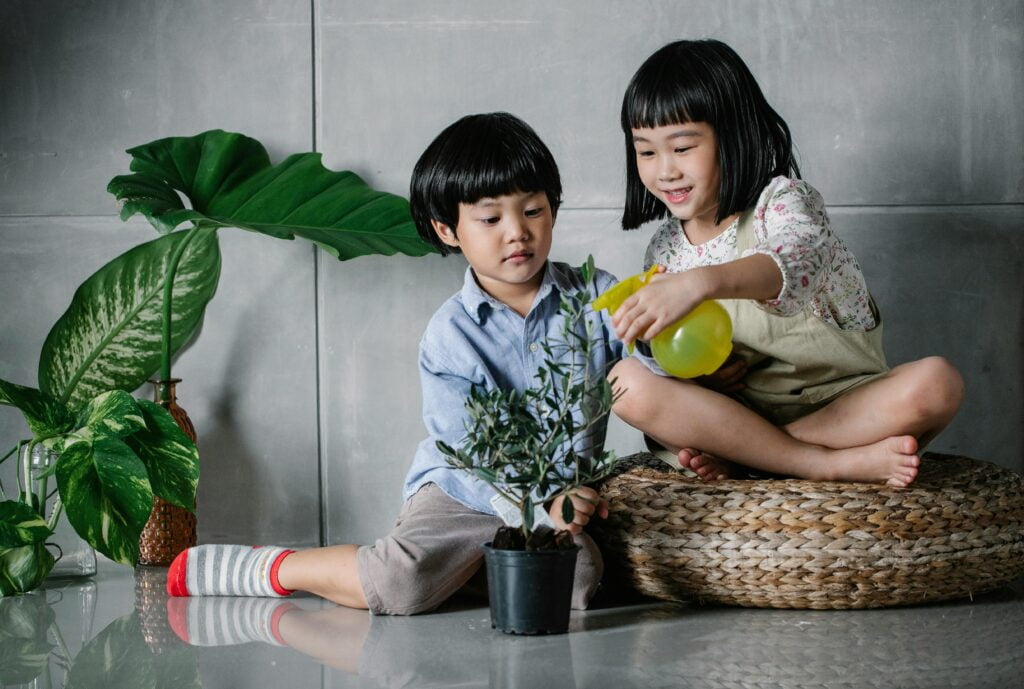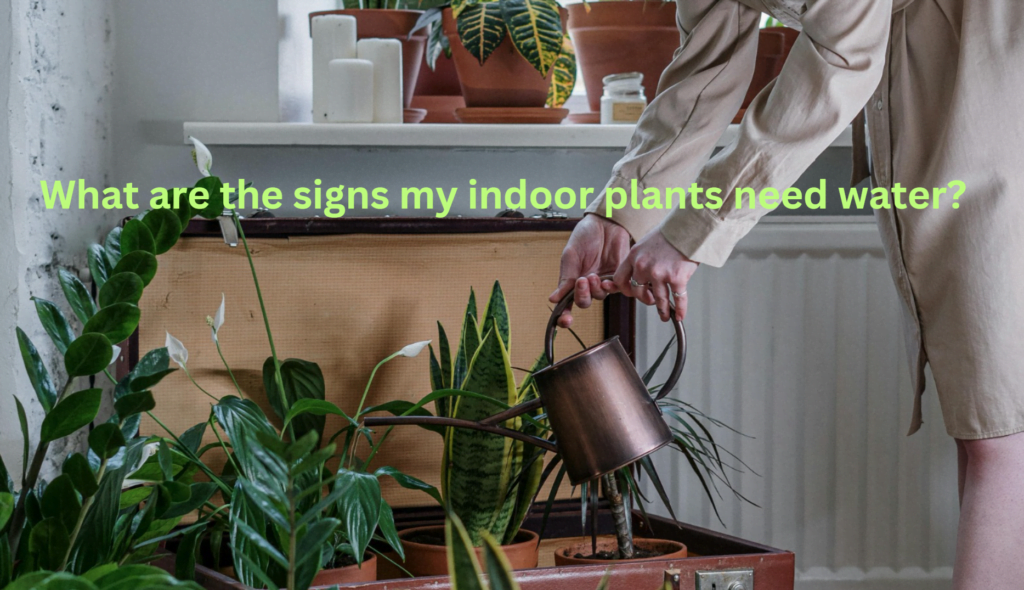‘How frequently should I water my houseplants?’ is a question we’re asked more than any other. Watering often creates a lot of confusion, but we assure you it’s quite straightforward. Plants can’t survive without water, but they probably don’t need as much as you might think. When it comes to watering your plants, the important things to remember are:

🌿 Check your plants at least once per week.
💧 Only water when the top two inches of soil feel dry.
☀️ In summer, plants may dry out quickly.
❄️ Cut back on watering in winter when plants aren’t growing.
🌱 Remember, plants like soil that’s lightly moist, never soggy.
✨ Those are the basics, but let’s delve deeper into watering. Also, here’s a quick tip if you always forget to water.
Checking Soil Moisture:

Simply stick your finger into the soil as far down as you can and see if the soil is dry. When you remove your finger, any soil sticking to it indicates moisture. When your finger comes out relatively clean, it’s time to water. Feel the soil by rubbing your fingers together.
How often should you water your plants?

There’s no one-size-fits-all answer. Plants need different amounts of water depending on the time of year and species.
In dry, hot summers, they may need water every couple of days. In winter, maybe every few weeks.
The general rule is: water when the top two inches of soil feel completely dry. That will prevent you from overwatering. Note: Some plants, including zz plants and corn plants, prefer their soil to dry out completely between drinks. Check your plant’s page to see how thirsty it is.
How should you water your houseplants :

Water the soil, not the leaves. This ensures it goes directly to the roots (and doesn’t splash all over).
Some people like to pour water into the plant’s saucer (if it has one), so the roots absorb it through the pot’s drainage holes. We don’t use this method; however, if it works for you, we support it.
Some plants prefer filtered water to hard tap water, meticulous beings (actually check your plant’s page to see if that’s yours). If you don’t have a filter, you can boil water, then let it cool completely before using it.
Watering Frequency:

In general, houseplants’ potting soil should be kept moist but not wet. They typically need watering once or twice a week in spring and summer, but less in autumn and winter. However, depending on the type of houseplant, this may not always be the case. It’s essential to research the particular needs of each plant species in your care and adjust your watering schedule accordingly.
What are the best watering techniques:

1. Water in the morning: Watering Early in the Morning or Evening. The early morning hours are the best time to water, but the late afternoon or early evening are also good times to water.
2. Drip irrigation: Drip Irrigation. Also known as trickle irrigation, the drip irrigation method allows water to drip slowly to the roots of plants through narrow tubes. A drip irrigation system is more expensive than a soaker hose but cheaper than an in-ground sprinkler system.
3. Mulch everything: In addition to beautifying the landscape, mulch provides numerous services in the garden, from managing weeds to controlling soil erosion. Mulch to Cut Down on Watering … The best thing to cut down on watering is mulching, which not only retains moisture in the soil but also keeps the soil cool and Mulch everything. Mulch reduces surface runoff and slows evaporation from the soil. Use the right tool. For efficient watering at the root zone, use a. Covering the soil with a thin layer of organic mulch such as compost, shredded. leaves … If the mulch is more than an inch thick, it can work against you by.
Water deeply: Water Deeply, Not Frequently. Think slow and deep when irrigating lawns and gardens; watering deeply and infrequently is much better than shallowly and often.
4. Water plants at the base: The roots absorb water and fill up the plant’s cells, strengthening its fibers to produce strong leaves and stems. Water the base of plants to avoid getting leaves wet and reduce foliar diseases. Avoid watering in the middle of the day when the hot sun will evaporate much of the water before it can get to thirsty plants.
5. Water slowly: If the soil surface is dry, water may puddle or run off and not be absorbed. The solution is to start slowly and gradually build up to a thorough soak. Too little water stresses lawns and plants, making them more susceptible to diseases, weeds, and insect pests. When you water cool soil in the evening, less water evaporates than when watering hot soil during the day. Over time, you get to know how heavy a pot should feel if the soil inside the pot is thoroughly moistened.
6. Sprinkler irrigation: Sprinkler irrigation is a method of applying water to the land in a manner that mimics natural rainfall. Water is distributed through a system of pipes. Sprinkler Irrigation. Sprinkler irrigation is generally used on farms where the water supply is plentiful, where the soil has the ability to hold water, and Water Sense labeled spray sprinkler bodies, which feature integral pressure regulation, can help decrease the outdoor water waste associated with irrigation. Maintain Sprinklers and Irrigation Systems.
7. Water the soil: “Watering the soil is essential for the health of your indoor plants. Directing water to the soil ensures it reaches the roots where it’s needed most. Avoiding watering the foliage helps prevent issues like fungal diseases and sunburn. By focusing on the soil, you provide your plants with the hydration they need to thrive.”
8. Avoid waterlogging: Avoid waterlogging – too much water can drown a plant’s roots, preventing them from getting oxygen and resulting in rotting roots.
9. Consistent watering: Watering by hand, while it can be time-consuming, is one of the best ways to deliver water to smaller areas, specific plants, and containers.
10. Build healthy soil: “Building healthy soil is crucial for the success of your plants. Incorporate organic matter like compost to improve soil structure and fertility. Promote beneficial microbial activity by avoiding chemical fertilizers and pesticides. Regularly mulching the soil helps retain moisture, suppress weeds, and provide nutrients.”
How can I ensure optimal root health for my plants :

Obviously, your trees and plants need healthy soil, a proper amount of water, light, and oxygen to grow healthy roots. Avoid unnecessary digging into the soil under the dripline of a tree to avoid causing root damage, which can stunt plant growth.
Why is proper drainage important for indoor plants:

When soil becomes overly saturated with water, the roots are deprived of oxygen. This can cause them to suffocate and eventually die, leading to a dying or dead plant.
“Why is consistency key in watering indoor plants?”: Adopting a consistent and well-planned schedule for watering, fertilizing, and pruning your plants can make a significant difference in your garden’s overall health and appearance. Just like humans, plants benefit from regular nourishment and care; each aspect contributes to their growth, vitality, and resilience.
“How can I adjust my watering routine to meet the specific needs of my indoor plants?”: “Different plants have different watering requirements. Be sure to research the specific needs of each plant in your care and adjust your watering routine accordingly to ensure their well-being.”
How can I effectively observe and adjust my watering practices to cater to the changing needs of my indoor plants?: “Pay attention to how your plants respond to watering. Adjust your watering frequency and volume based on factors such as seasonal changes, plant growth stages, and environmental conditions to meet their evolving needs.” Also, when watering, it is essential not to exceed the amount of water used. A simple trick to know when to water is to stick a finger in the soil halfway through the pot. If it’s wet when you take it out, it means you don’t need to water yet. If it’s dry, it’s time to provide water to the plant.
What are the essential healthy practices I should follow to ensure the well-being of my indoor plants?: “Incorporate proper watering practices into your overall plant care routine to promote healthy growth, vibrant foliage, and beautiful blooms. With the right approach, watering can be a nurturing act that fosters a thriving indoor garden.”
Match plants with light conditions. Houseplants vary in their light requirements. …
Choose the right container. …
Use good-quality potting soil. …
Water properly. …
Fertilize and control pests. …
Increase humidity and prevent drafts. …
Keep foliage clean.

“All in all, becoming amazing at watering your indoor plants is fundamental for their health and vitality. By understanding the particular requirements of each plant, checking soil moisture levels regularly, and using proper watering procedures, you can establish an ideal climate for your indoor vegetation to flourish. Make sure to adjust your watering routine in view of seasonal changes, plant growth stages, and environmental circumstances, and always aim for consistency in your care practices. With these principles in mind, you’ll be well-equipped to nurture a thriving indoor garden and enjoy the beauty and benefits of your plants for years to come.”



